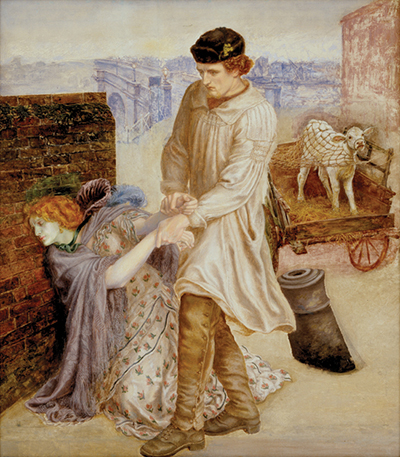Dante's only work of the 1850s that was done in oils, broached the moral contemporary subject of prostitution, a change from his usual subjects of medieval scenes and early Renaissance revival works. Dante considered Found one of his most important works, working on it from the 1850s until his death and it remains unfinished. It is now in the Delaware Art Museum's collection.
His model was Fanny Cornforth, whom Dante met in 1858 and who subsequently became his mistress. A number of studies in both black and brown ink as well as pen and ink have been found which are believed to be the foundations of the work. The white calf and cart behind the girl and farmer depicted in the painting are believed to represent the innocence of the girl and to show the acceptance both of her fate and that of the calf, on its way to market to be sold. It is said that Dante struggled with the image of the calf, cart and wall, asking his mother and sister in letters written to them both, for help to find a suitable model for him to paint. He also wrote to William Holman Hunt describing the painting and quoted Jeremiah 2:2, which was also found on two earlier studies for the work.
Originally comissioned by Francis McCracken who ultimately cancelled the comission due to little progress, it was then industrialist James Leathart's turn to comission the work, followed by William Graham. William Graham ultimately became the owner of Found upon Dante's death, selling it to British ship owner Frederick Richards Leyland who sold the work a part of an estate sale collection at Christie's in 1892.
Samuel Bancroft, a textile mill owner from Delaware purchased Found as part of this estate sale collection. The owner of one of the biggest collections of Pre-Raphaelite works outside of the United Kingdom, the painting was displayed in Bancroft's home office. It was donated to the collection at the Wilmington Society of the Fine Arts in 1935 by his family who also purchased land upon which the museum expanded. Today the museum is the Delaware Art Museum.




